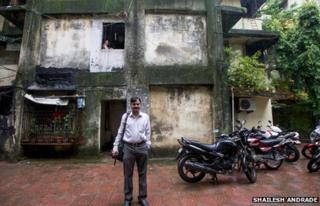Why people live in Mumbai’s dangerous buildings
More than 100 people have died after the buildings they were living in collapsed in India’s financial capital, Mumbai, between April and June this year. The BBC’s Kinjal Pandya investigates why hundreds of people are forced to live in these dangerous buildings.
Braj Bhushan Chaubey is a young sales executive who lives in what the local municipality calls a “dangerous building” in Mumbai.
His home in Dadar area is a grotty, decaying three-storey building which the authorities, in a warning to its 50 residents, say is in a “ruinous condition, likely to fall and dangerous to any person occupying or passing by”.
The walls have deep cracks and the paint is peeling. In his tiny 150sqft apartment, where Mr Chaubey lives with his wife and a school-going seven-year-old daughter, a slab of the kitchen ceiling fell a few months ago.
“But I am forced to live here in danger. I cannot buy or rent a new flat in the neighbourhood because they are very expensive and I cannot afford them. Also, if I move out of my neighbourhood I will have to live far away from my office and my daughter’s school, resulting in long commuting hours,” he says.
Dodgy buildings
Property prices and rent in Mumbai are among the highest in Asia. Many citizens are forced to live in old, dilapidated properties in a land-scarce city where an estimated 60% of its 18 million people live in slums and shantytowns.
There are more than 14,000 buildings in Mumbai that are more than 70 years old. Due to an archaic law which limits raising rents, many tenants pay as low as $1-$20 (65 pence-£13) a month, leaving the landlords with little money to invest in repairs and maintenance.
No wonder then that 959 buildings like Mr Chaubey’s home have been branded as “dilapidated and dangerous” by the city’s municipality. And every year, a number of these buildings collapse, leading to many deaths.
Over 100 people have been killed in five building collapses between April and June alone. And between 2008 and 2012, there were 100 building collapses in which 53 people died and 103 others were injured, authorities say.
Dilapidated buildings and low rents are only part of the story. In a densely populated city where quality, affordable housing is scarce, realtors often cut corners to make what many call sub-standard buildings, putting the buyers at risk.
Though there are nearly half a million pricey apartments which lie vacant as sellers look for rich buyers, millions of middle class residents get squeezed out to the suburbs and outskirts to live in these dodgy new buildings.
Corruption
The corruption in the housing sector – complex regulation leading to collusion between a section of builders and government workers – worsens matters and leads to poor quality buildings coming up in the city.
“Unscrupulous builders build homes without taking requisite permissions using poor construction material. We have seen a number of house collapses in these areas,” says Chandrashekhar Prabhu, a prominent housing activist.
Municipal authorities insist that they have stepped up efforts to demolish illegal and dangerous buildings and evacuate the residents.
”We first issue an evacuation notice to the residents. We have to sometimes take help from the police to evacuate people who are unwilling to leave. We also cut off the electricity and water supply to force them to leave,” says Navnath Ghadge of Mumbai’s municipality.
But hundreds of people continue to live and risk their lives in old, decrepit, and badly constructed buildings.
Khairun Bi, 63, lost her entire eight-member family when the building they were staying in collapsed in June.
She says she has still not received any help from the authorities.
‘I do not have anywhere to go now. I have lost everything, my family and shelter. The government has not done anything for me – neither have I received any compensation, nor have I got a transit home to stay after the collapse.”
Source: Read Full Article



